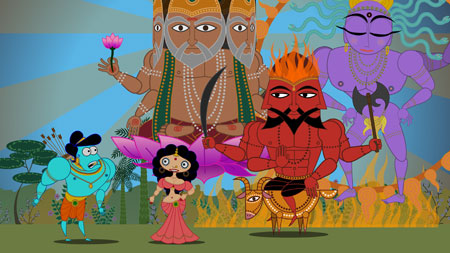Sita Sings the Blues

They worship me as One and as many, because they see that all is in me.
-Krishna, Bhagavad Gita 9:15
Since its authorship sometime 2,500 years ago, the Ramayana by Valmiki, one of two major Hindu epics, has been translated and adapted countless times. Having been born in India to Kashmiri parents, I am well aware of India’s conservatives who get bent into hysterics over how the country is presented. This was no more evident to me than in 2005, while interviewing Deepa Mehta regarding her film Water, about the historical ostracism of widows from Hindu society. Mehta had to cease production in 2001 due to violent protests, and resumed production in 2005 in Sri Lanka. She couldn’t go anywhere without bodyguards. It baffles me that I come from such a culture, whose own religion is, as the above quote from one of their most sacred texts underscores, henotheistic—tolerant of differing views and interpretations.
Now I learn that Nina Paley’s beautifully-animated adaptation has come under fire from Hindu extremists who argue that it is blasphemy. It’s certainly no surprise, as she has co-opted one aspect of the story, Rama’s inexplicable rejection of his otherwise devoted Sita (voiced here by Reena Shah) for having ventured out against his will, Paley incorporated her own personal rejection as a parallel.
Naturally, protestors will dredge up “bitter feminist” stereotypes in support of their thesis, wholly ignoring the myriad interpretations that have incited debate for centuries. When you take a stab at re-imagining a sacred text, some individuals are bound to take offense. I do see a problem in Paley’s motivations: In addition to co-opting a story for her own film, she has also banged a very loud drum against the copyright owners of Annette Hanshaw’s music which she originally used without securing permissions. One could argue that her views on derivative works and sampling are no less self-serving—attempting to make a living entirely from rearrangement of someone else’s work. Though, that is another debate.
The film, however, is marvelous. Combining three or four different styles of animation, Paley begins the story in what appears to be an ethereal plane, with vibrant explosions that evoke the Big Bang—the birth of the universe as we know it. Enter a woman in San Francisco whose boyfriend is offered a job in India. The woman, without guessing, is based on Nina Paley who began composing the animation for Sita after following him there, only to be left alienated.
Paley occasionally brings us back to this story, which is treated too placidly to endear us. Instead, the heart lies in the retelling of this chapter of Ramayana through the hilarious, informal musings of three narrators, voiced by Aseem Chhabra, Bhavana Nagulapally and Manish Acharya. Immediately they open our epic struggling, to great comic effect, to recall when it was written, who the players were, and the events that transpired. This is a tone familiar to me, as I’d spent many hours listening to philosophical chats at Indian social gatherings—humorous debates over a cup of tea. “Oh god they’re going to get me for that one,” mutters one of the narrators after confusing the name of Surpanakha, a pivotal character in the epic tale.
The story shifts effortlessly between the two-dimensional collage style of the narrator segments, the classical artistic design of the Rama-Sita story, the pencil sketch style of the modern story, and finally Hanshaw’s musical numbers in a two-dimensional style with surprising visual depth. There are rakshasas (demons), one-eyed bat-like creatures and gods all playing their part.
Some individuals have argued that Sita has historical inaccuracies but in the world of mythology and myth-telling I believe that is missing the point. Paley’s use of the Hanshaw-backed musical lamentations elucidates one of many concepts—thankless devotion—that one may intuit from the Ramayana. In the end Sita’s commitment is recognized and rewarded by the gods. Who holds a candle for Sita? Nina Paley certainly does. Who holds a candle for Ms. Paley? Everyone who acknowledges her journey by watching this film.
Sita Sings the Blues is being made available for download by Nina Paley here. It is scheduled to be released on DVD today, and is playing at film festivals around the country.
 Sita Sings the Blues • Dolby® Digital surround sound in select theatres • Aspect Ratio: 1.85:1 • Running Time: 82 minutes • MPAA Rating: Not Rated. • Distributed by Nina Paley
Sita Sings the Blues • Dolby® Digital surround sound in select theatres • Aspect Ratio: 1.85:1 • Running Time: 82 minutes • MPAA Rating: Not Rated. • Distributed by Nina Paley